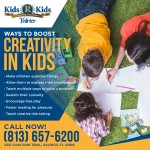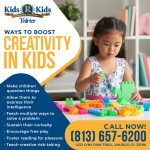7 ways to boost creativity in kids
Research says that creativity is not an inborn talent but a skill that can be built. Creativity is crucial for young children as it helps them express and cope with their feelings. Moreover, it fosters mental growth in them by providing opportunities to experiment with new ideas, new ways of thinking, and problem-solving. Kids ‘R’ Kids shares a few ways caregivers can help boost this skill in young children.
What is creativity?
Creativity is the process of turning new and imaginative ideas into reality. It is characterized by the ability to perceive the world in new ways, to find hidden patterns, to make connections between seemingly unrelated events, and to generate innovative solutions. Creativity involves two processes - thinking and producing.
Creativity is the key to success in every sphere of life. It plays a crucial role in improving the brain’s cognitive abilities. Moreover, according to research, creative thinking helps the brains develop neural connections and learn new concepts. People with a musical background, for example, tend to have stronger links between the two hemispheres in their brain. Having said that, creativity is not limited to artistic and musical expression only. It is also essential for science, mathematical, linguistic, bodily-kinesthetic, spatial, naturalist, and even social and emotional intelligence. Creativity allows enables an individual to be more flexible and emerge as a better problem solver.
Here are some ways to help boost creativity in children:
1. Make children question things
Children are naturally inquisitive. By encouraging them to question what they see and hear lays a strong foundation of understanding and critical thinking. Urging kids to wonder and ask questions such as why, how, what if are ways to encourage their curiosity and develop problem-solving skills. Why is the sky blue? How does a bird fly? What if fishes could fly?
2. Allow them to express their intelligence
Every child is unique. According to the multiple-intelligence theory, every child has a dominant type of intelligence that is used to understand the world and express. The not-so-dominant intelligence in every child can be developed with time. Children must be allowed to express all forms of intelligence and their natural inclination must be encouraged.
3. Teach multiple ways to solve a problem
From a math problem to a conflict with classmates, a caregiver must introduce children to the concept of multiple solutions to a problem. Giving them an understanding of different perspectives and encouraging empathy helps children develop strong problem-solving skills. It takes a lot of creativity and perspective to find solutions that work for everyone, every time. This is a skill that is extremely useful in personal and professional relationships.
4. Sustain their curiosity
Creativity is the cornerstone of innovation. Even though children are born curious they need the right environment with a sense of safety and novelty to sustain their curiosity. In the absence of the freedom to ask questions, explore new thoughts, and a rich and novel atmosphere, curiosity can die an early death. Children’s curiosity can be fostered for instance by exposing them to the rich art, culture, and literature of a country and enlightening them of their hidden meanings and implications. Discussions about the environment and the factors that are endangering it. These meaningful conversations expand a child’s knowledge base allowing them to remain curious and continue their learning.
5. Encourage free play
Creative thinking is encouraged in the absence of rules and structure. Free play and the absence of gadgets enable the development of this skill. Not only does free play allow out-of-the-box thinking it also helps in the development of various other skills such as coordination, self-expression, and so on. Handing children a bunch of crayons, encouraging make-believe-play or just some unadulterated time with playdough or sand can do wonders for a child’s creative intelligence.
6. Foster reading for pleasure
A creative hobby like reading encourages thought activity which in turn promotes creativity. Reading helps children understand the world at large, builds their vocabulary to express themselves, develops their logical thinking, and imparts new information. Visiting the library, reading to them at bedtime, discussing their favorite books and their characters, and enacting some of the books they love is a great way to build their knowledge base and sustain their curiosity.
7. Teach creative risk-taking
Children must be encouraged to take creative risks so they can step out of their comfort zones and learn something new, even at the risk of failure. This risk-taking teaches them about their capabilities, encourages them to learn more complicated ideas and skills, and teaches them to be OK with failure. The idea is to teach them to focus more on the creative process than the outcome.
Why Kids ‘R’ Kids?
The philosophy of “Hug First, Then Teach”, defines every aspect of what Kids ‘R’ Kids, Valrico stands for. Unlike many daycare centers or childcare providers, its methodology is a whole-child approach. It constantly strives to strengthen and encourage every child’s emotional, intellectual, social, and physical well-being through the expertise of its childcare providers and a unique partnership with parents.
Kids ‘R’ Kids International is accredited by AdvancED®, the world’s largest education community, and the Southern Association of Colleges and Schools Council on Accreditation and School Improvement (SACS/CASI). SACS/CASI is an accreditation division of AdvancED®. This accreditation ensures that the high accreditation standards are met and exceeded.

























